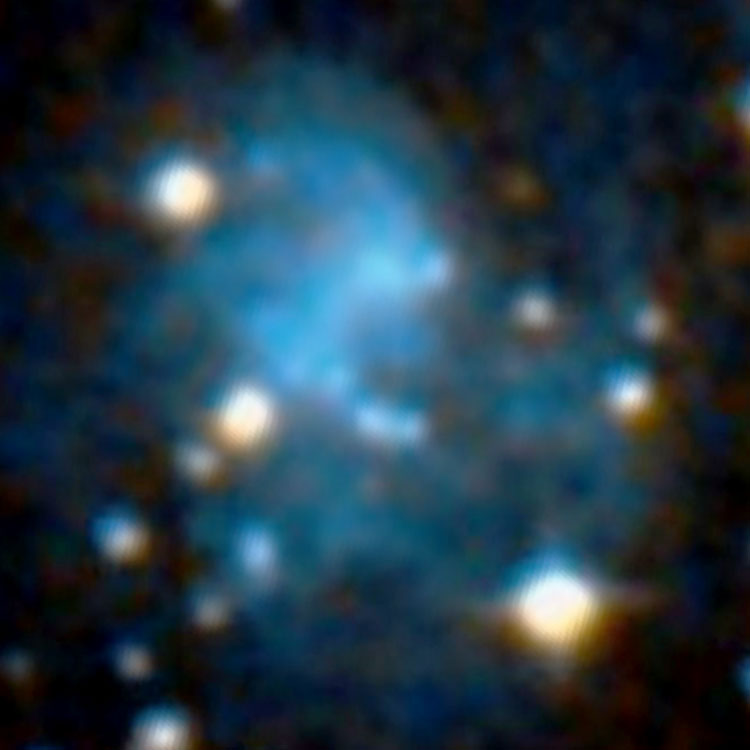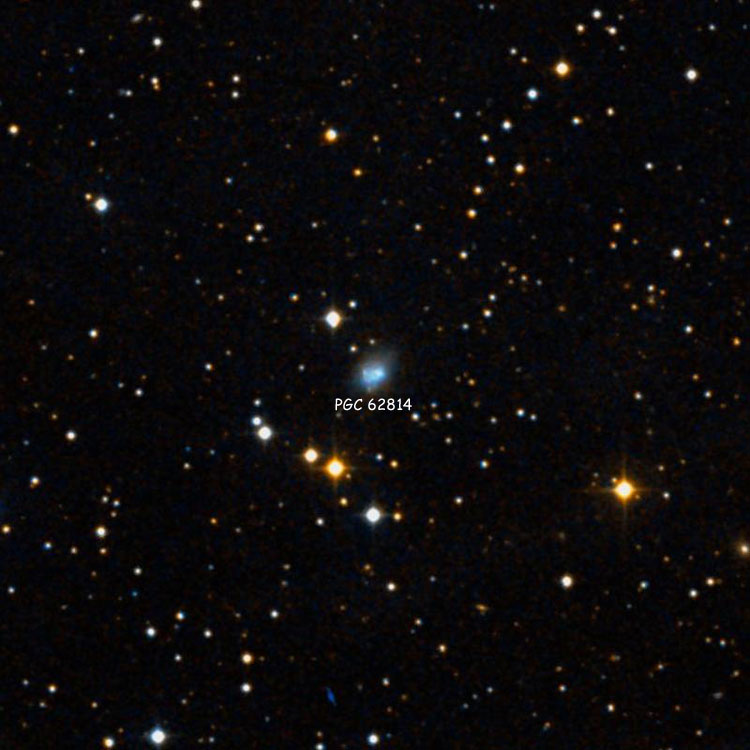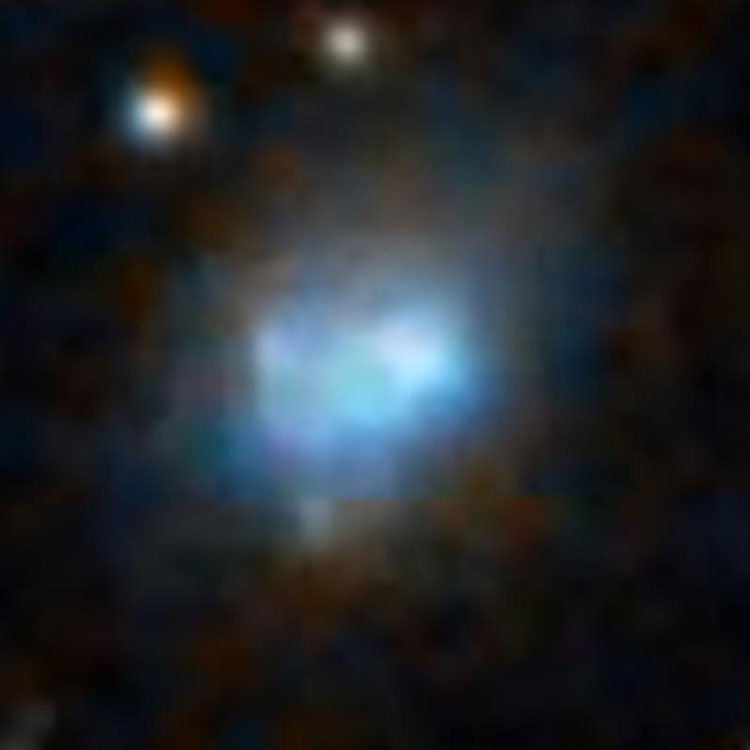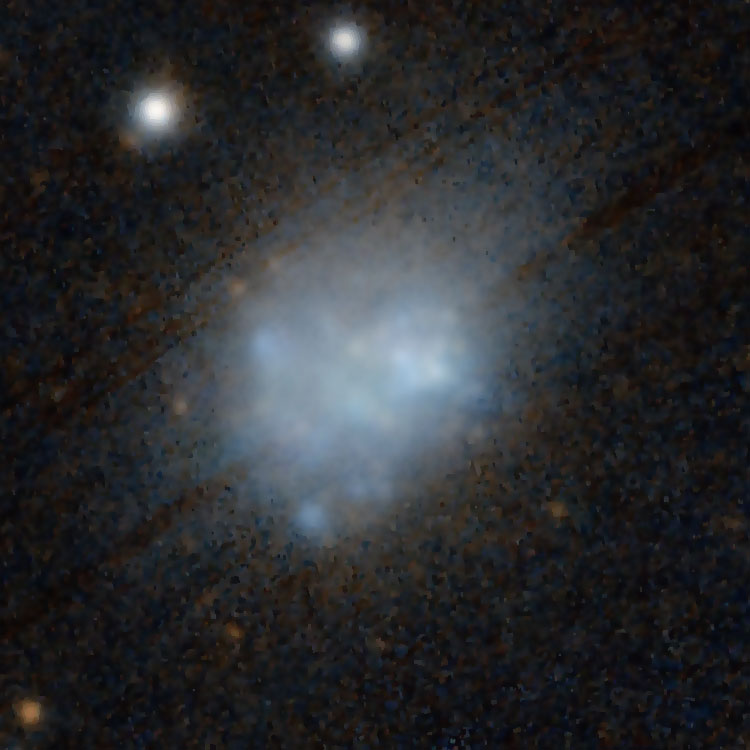Page last updated May 24, 2020
PGC 62775 (= ESO 184-011)
A magnitude 13.5(?) irregular galaxy (type IB(s)m pec?) in Telescopium (RA 19 06 21.4, Dec -56 09 42)
Physical Information: Based on a recessional velocity relative to the Cosmic Microwave Background of about 2610 km/sec (and H0 = 70 km/sec/Mpc), PGC 62775 is about 120 to 125 million light years away. Given that and its apparent size of about 1.5 by 1.3 arcmin (from the images below), it is about 50 to 55 thousand light years across. It is an apparent companion of IC 4817, and since their recessional velocities only differ by 400 km/sec, it is possible (though not certain) that they are also physical companions, or had a recent close passage which caused their peculiarities.

Above, a 12 arcmin wide DSS image centered on PGC 62775, also showing IC 4817
Below, a 1.8 arcmin wide DSS image of the galaxy

PGC 62814 (= UGC 11411)
A magnitude 14(?) irregular galaxy (type Irr/BCD) in Draco (RA 19 08 43.1, Dec +70 17 02)
Physical Infomation: PGC 62814 has a recessional velocity relative to the Cosmic Microwave Background radiation of -35 km/sec (±39 km/sec) , which means that its peculiar velocity (its random motion relative to other galaxies in its neighborhood) is larger than the velocity it should have as a result of the Universal Expansion, making its recessional velocity useless as a distance indicator. However, a single redshift-independent distance estimate of a little over 20 million light years appears to be a reasonable value. Based on that and its apparent size of about 1.15 by 0.7 arcmin (from the images below), the galaxy is about 7 thousand light years across, justifying its classification as a dwarf galaxy.
Classification Note: PGC 62814 ia an example of a "blue compact dwarf" (= BCD), a small irregular galaxy undergoing a burst of star formation which, since such galaxies contain many hot, bright, bluish-white stars, gives them an excess of blue and ultraviolet light in their spectrum. Such galaxies typically have very few old stars (in this case most of the stars we see were only about 10 million years old when the light by which we see them left the galaxy), and as a result contain almost no elements other than hydrogen and helium. This makes them an ideal place to study the formation of stars in the early universe, when there were no elements other than hydrogen and helium in any galaxy.

Above, a 12 arcmin wide SDSS image centered on PGC 62814
Below, a 1.2 arcmin wide SDSS image of the galaxy

Below, a 1.2 arcmin wide PanSTARRS image of the galaxy

Below, a 1.2 arcmin wide HST image of the galaxy (Image Credit ESA/Hubble & NASA)

PGC 62815 (= "NGC 6744A")
Not an NGC object but listed here because sometimes called NGC 6744A
PGC 62946 (= ESO 593-008), "The Bird"
A magnitude 14(?) triplet of colliding galaxies in (RA 19 14 31.1, Dec -21 19 09)
Physical Information: Based on a recessional velocity relative to the Cosmic Microwave Background of 14450 km/sec (and H0 = 70 km/sec/Mpc), a straightforward calculation indicates that PGC 62946 is about 670 to 675 million light years away. However, for objects at such distances we should take into account the expansion of the Universe during the time it took their light to reach us. Doing that shows that the system was about 635 million light years away at the time the light by which we see it was emitted, about 650 million years ago (the difference between the two numbers being due to the expansion of the intervening space during the light-travel time). Given that and its apparent size (including the extended regions cast out of the central galaxies by their interaction) of about 0.8 by 0.7 arcmin (all apparent sizes estimated from the images below), the system is about 145 to 150 thousand light years across. The spiral galaxy aligned more or less east-west (left-right in the images) spans about 0.5 by 0.1 arcmin or 90 to 95 thousand light years. The spiral galaxy aligned more or less north-south (top-bottom in the images) spans about 0.45 by 0.1 arcmin or 80 to 85 thousand light years. The irregular galaxy spans about 0.15 by 0.12(?) arcmin or 25 to 30 thousand light years.
The system has generally been considered to be two large spiral galaxies in the early stages of a spectacular collision; but the ESO image reveals three apparent cores, interpreted as the centers of the two spiral galaxies and of a third, smaller irregular galaxy. All three should eventually coalesce into a single galaxy, but the process will take hundreds of millions of years, during which the collision of clouds of gas in the three objects will produce huge numbers of new stars, many of which will be bright massive objects whose death throes will fill the 'new' galaxy with supernova remnants whose expanding shells of ejected material will create shock waves in the remaining interstellar medium and give birth to still more stars; so in comparison to the short span of human life, this will remain a spectacular object 'forever'.

Above, a 12 arcmin wide DSS image centered on PGC 62946
Below, a 0.9 by 1.2 arcmin wide image of the trio, using the HST false-color parameters
(Image Credit NASA/ESA/Hubble Heritage Team (STScI/AURA),ESA/Hubble Collaboration
and A. Evans (University of Virginia, Charlottesville/NRAO/Stony Brook University))

Below, a 0.6 by 0.55 arcmin wide false-color image showing the three cores (Image Credit ESO)

|